

Chem. J. Chinese Universities ›› 2023, Vol. 44 ›› Issue (5): 20220775.doi: 10.7503/cjcu20220775
• Review • Previous Articles
ZHANG Xiaoyu1, QU Gan1, XUE Dongping1, YAN Wenfu2( ), ZHANG Jianan1(
), ZHANG Jianan1( )
)
Received:2022-12-30
Online:2023-05-10
Published:2023-02-24
Contact:
YAN Wenfu, ZHANG Jianan
E-mail:yanw@jlu.edu.cn;zjn@zzu.edu.cn
Supported by:CLC Number:
TrendMD:
ZHANG Xiaoyu, QU Gan, XUE Dongping, YAN Wenfu, ZHANG Jianan. Recent Process of Carbon-based Catalysts for the Production of H2O2 by Electrocatalytic Oxygen Reduction: Strategies, Calculation and Practical Applications[J]. Chem. J. Chinese Universities, 2023, 44(5): 20220775.
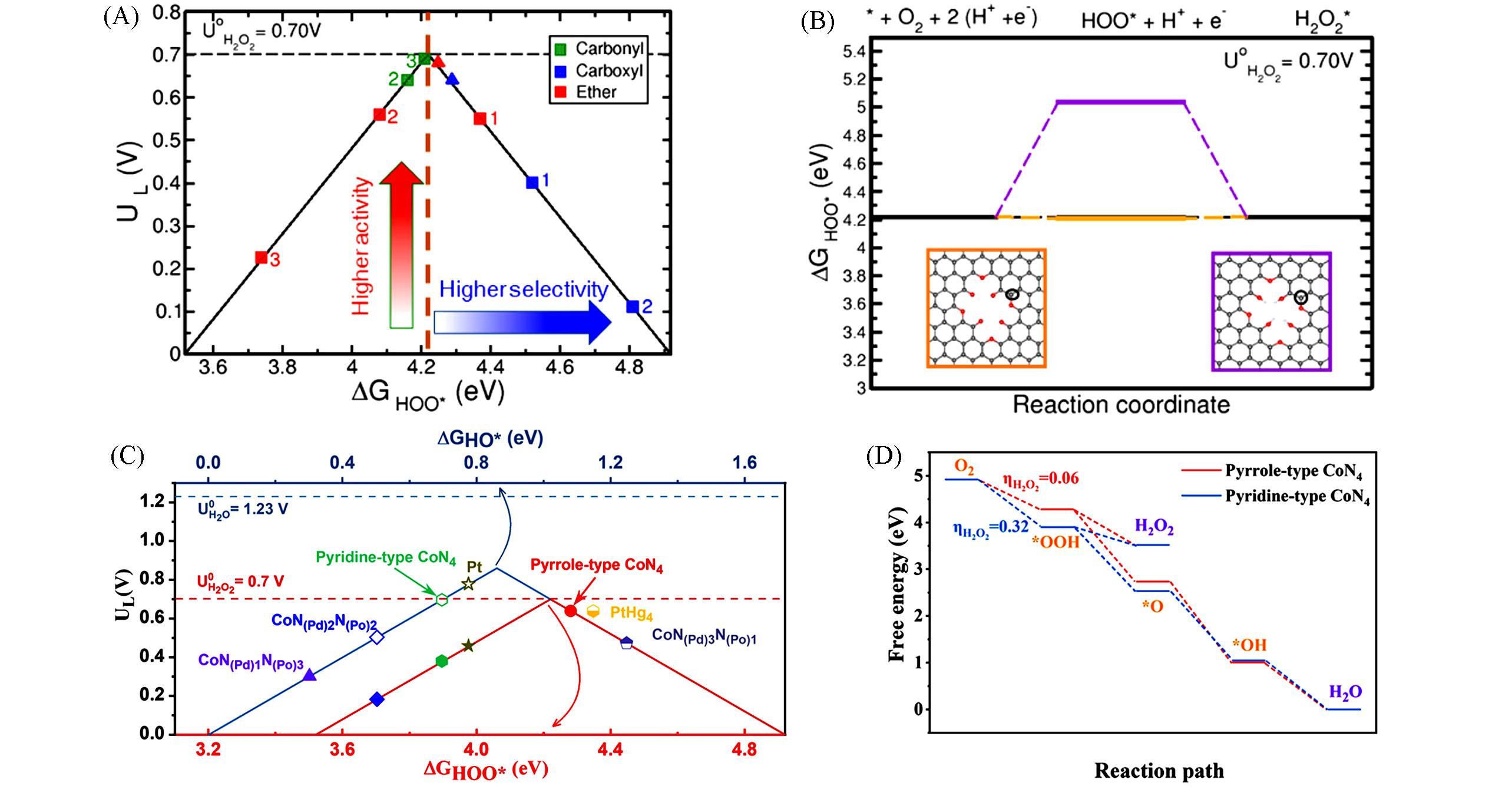
Fig.3 Activity volcano plots of 2e ‒ ORR pathway for different structures(A), free energy diagram for 2e ‒ ORR on different structuresl(B)[50], the activity volcano plots of 2e ‒ and 4e ‒ ORR pathways on different Co⁃N coordination structures(C), free energy diagram of ORR on CoN4 with different nitrogen coordination(D)[51]
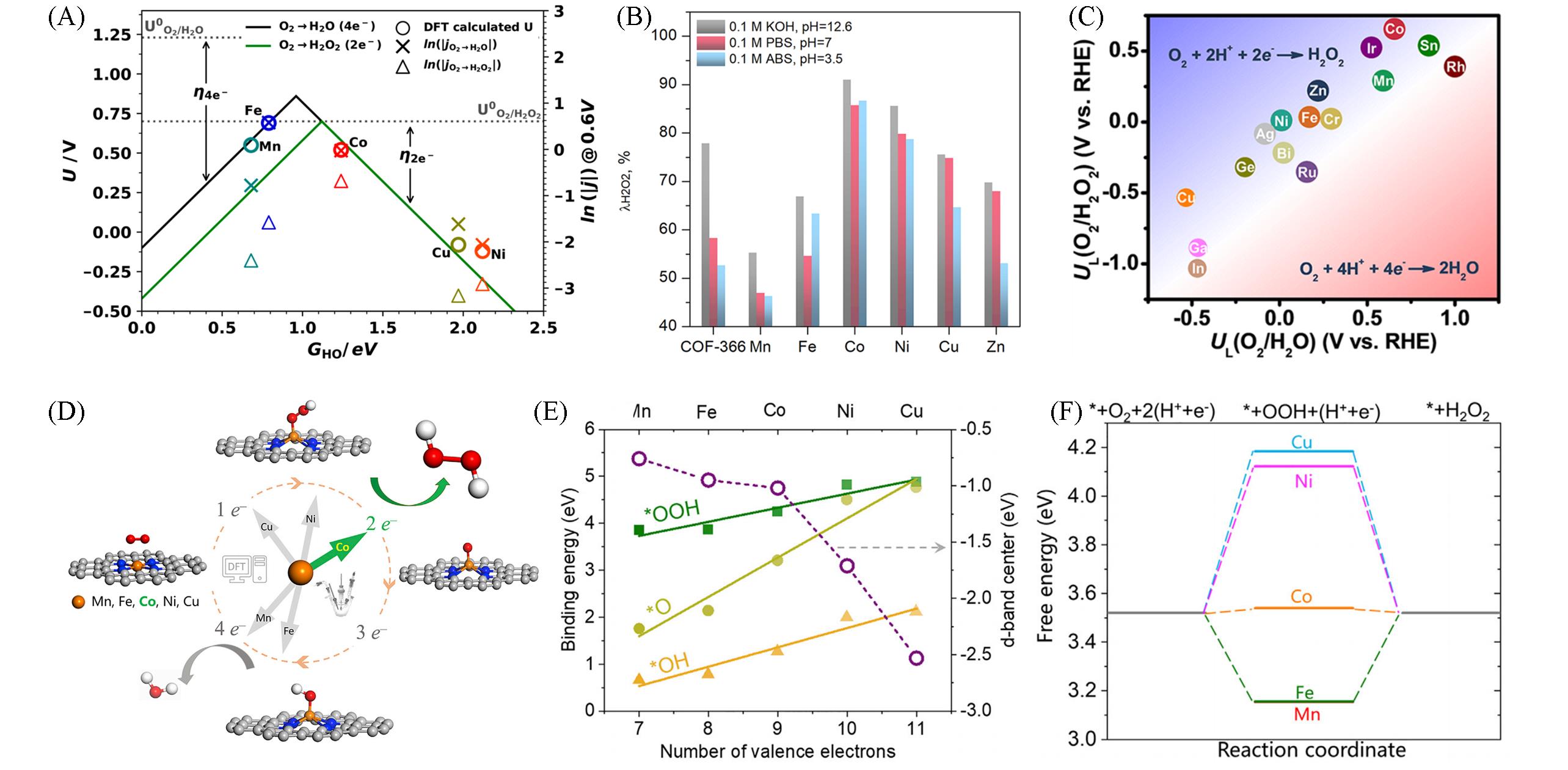
Fig.4 Activity volcano plots for the 2e‒ and 4e‒ ORR(A)[68], H2O2 selectivity in three types of electrolytes(B)[67], activity volcano plots of different metalloporphyrins for 2e‒ ORR and 4e‒ ORR(C)[69], schematic of ORR along the 2e‒ or 4e‒ pathway on transition metal SACs anchored in N⁃doped graphene(D), binding energy of *OOH, *O, and *OH on M⁃SAC(E) and free energy diagrams of 2e‒ ORR on M⁃SAC at U=0.7 V(vs. RHE)(F)[45](A) Copyright 2019, American Chemical Society; (B) Copyright 2020, American Chemical Society; (C) Copyright 2022, Springer Nature; (D—F) Copyright 2020, Elsevier.
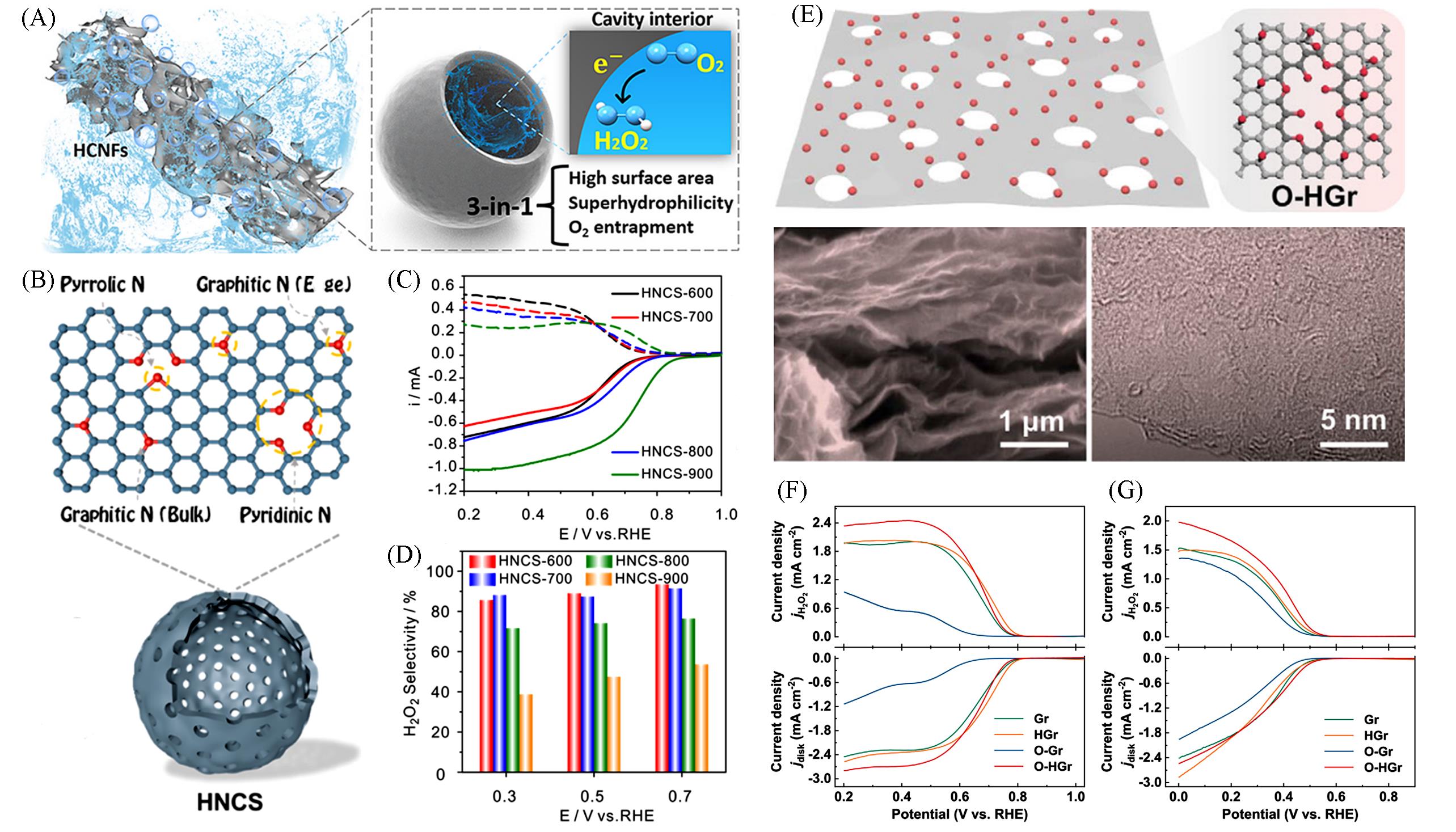
Fig.5 3⁃in⁃1 Effect of HCNFs promotes O2⁃to⁃H2O2 conversion(A)[88], schematic illustration of HNCS(B), LSV curves(solid lines) and H2O2 oxidation ring current adjusted by collection efficiency(C), H2O2 selectivity for different catalysts in O2⁃saturated 0.1 mol/L KOH(D)[89], schematic illustration of the microscopic characterization of O⁃HGr electrocatalysts(E), linear sweep voltammetry(LSV) of O⁃HGr at 1600 r/min in alkaline(F), LSV of O⁃HGr at 1600 r/min in neutral electrolytes(G)[50](A) Copyright 2021, Wiley-VCH; (B—D) Copyright 2021, American Chemical Society; (E—G) Copyright 2022, Wiley-VCH.
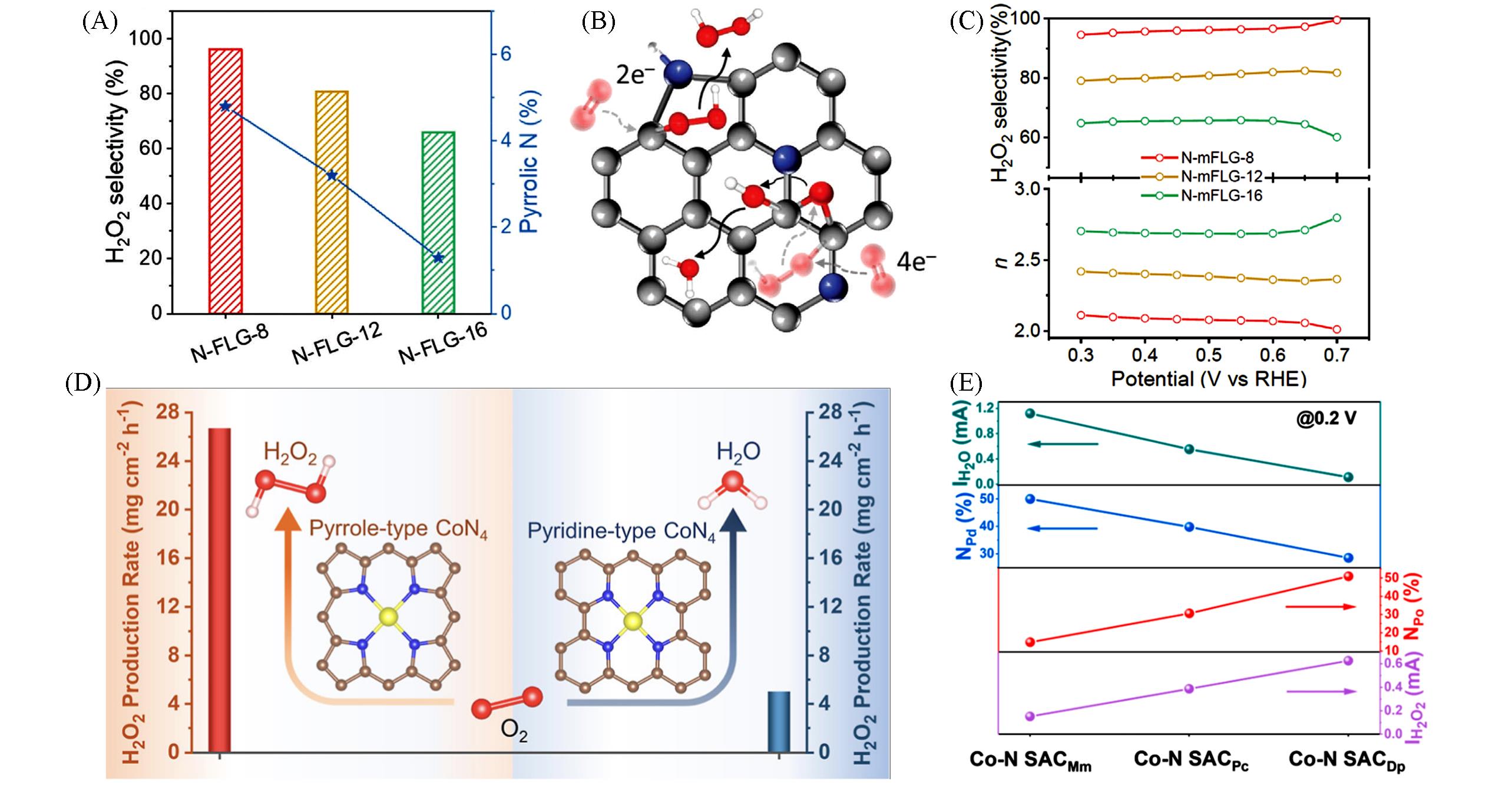
Fig.6 Relationship between H2O2 selectivity and atomic content of pyrrolic⁃N(A), schematic diagram of ORR pathways on N⁃FLG(B), H2O2 selectivity and electron transfer number(n) calculated from rotating ring disk electrode(RRDE) test(C)[94], simulated CoN4 coordination structures and H2O2 production rate for different catalysts(D), relationship between disk and ring current at 0.2 V(vs. RHE) and the content of N species for the three Co⁃N SACs(E)[51]
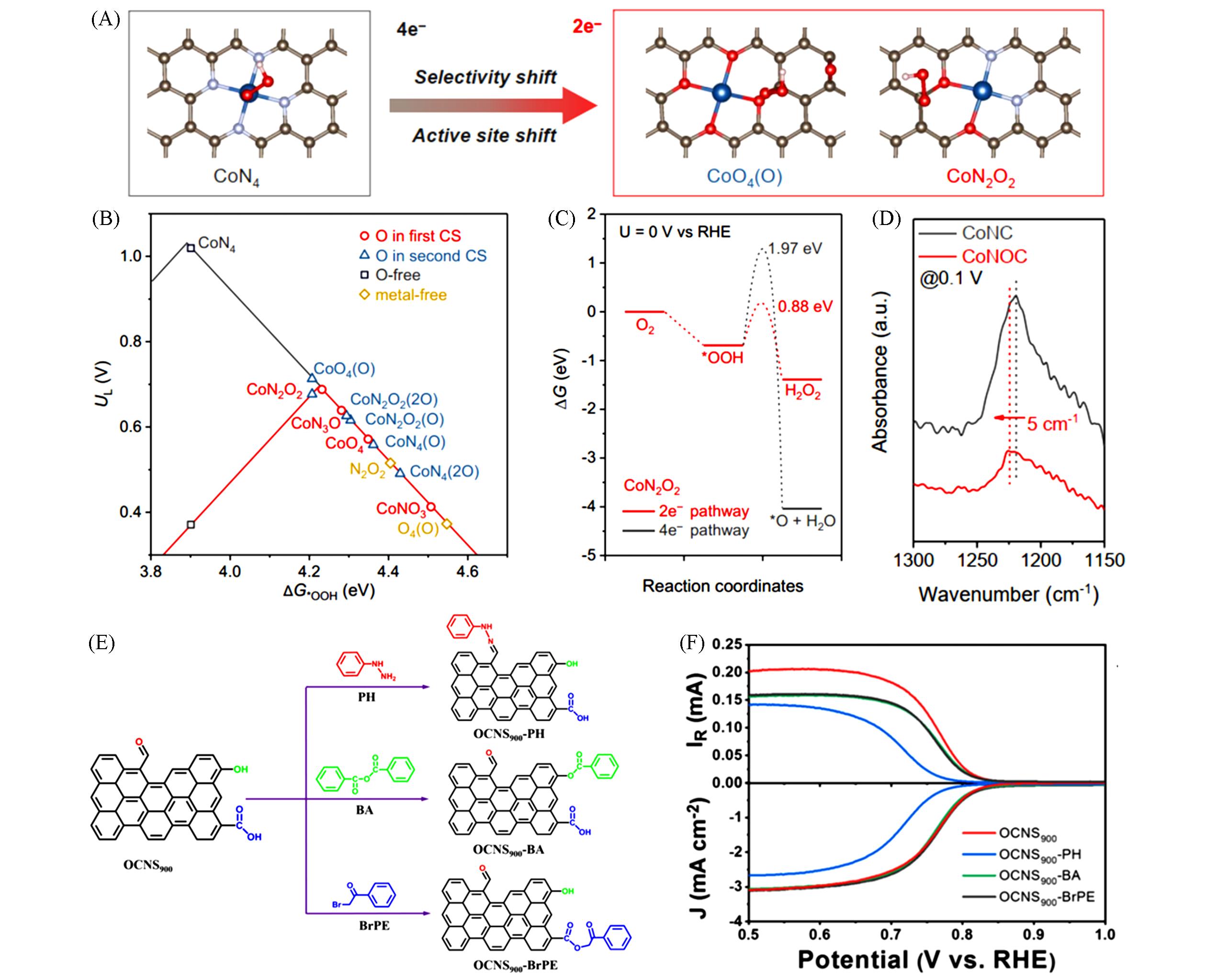
Fig.7 Optimized geometry structures of *OOH adsorption on Co SACs(A), computed activity volcano plots of ORR via the 2e ‒ or 4e ‒ pathway for varied Co SACs(B), free energy diagram for the 2e ‒ or 4e ‒ ORR pathway(C), in⁃situ ATR⁃SEIRAS spectra recorded on Co SACs(D)[74], schematic diagram of the chemical titration(E), LSV of different catalysts in 0.1 mol/L KOH(F)[103]
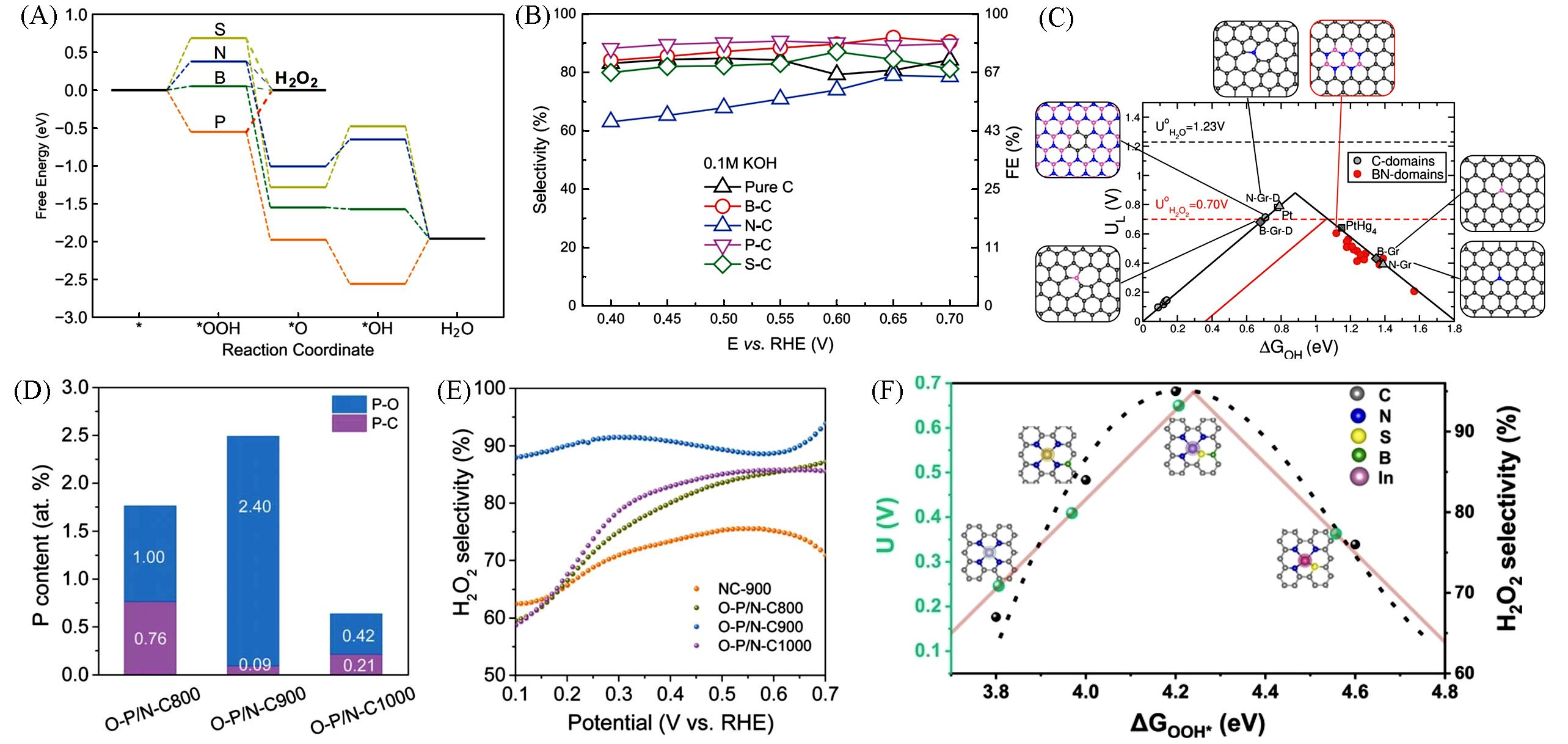
Fig.8 Free⁃energy profile of O2 reduction paths(A), H2O2 selectivity and Faradaic efficiency during for different catalysts in 0.1 mol/L KOH(B)[105], theoretical activity volcano plots for 2e‒ and 4e‒ ORR pathway of the N⁃ or B⁃doped graphene(C)[106], atomic contents of different P species(D), H2O2 selectivity of different catalysts calculated from RRDE test(E)[107] and calculated catalytic activity volcano plots for the production of H2O2via the 2e‒ ORR process(F)[108]
| Catalyst | Strategy | Electrolyte | Selectivity [H2O2%] | Onset potential versus RHE | Ref. |
|---|---|---|---|---|---|
| Co⁃NC | Single atom | 0.1 mol/L HClO4 | 90 | 0.6 | [ |
| COF⁃366⁃Co | Single atom | 0.1 mol/L KOH | 91 | — | [ |
| Co⁃N⁃C | Single atom | 0.5 mol/L H2SO4 | 80 | 0.78 | [ |
| CoSA⁃N⁃CNTs | Single atom | 0.5 mol/L H2SO4 | 95 | 0.7 | [ |
| HCNFs | Defect engineering | 0.1 mol/L KOH | 97.3 | 0.75 | [ |
| HNCS | Defect engineering | 0.1 mol/L KOH | 90 | 0.7 | [ |
| MNC⁃50 | Defect engineering | 0.5 mol/L H2SO4 | 90 | — | [ |
| O⁃HGr | Defect engineering | 0.1 mol/L KOH | 95 | 0.79 | [ |
| N⁃FLG | Pyrrole nitrogen | 0.1 mol/L KOH | 100 | 0.8 | [ |
| Co⁃N SACDp | Pyrrole nitrogen | 0.1 mol/L HClO4 | 90 | — | [ |
| O⁃CNTs | Oxygen functionalization | 0.1 mol/L KOH | ca. 90 | 0.60 | [ |
| F⁃mrGO | Oxygen functionalization | 0.1 mol/L KOH | ca. 100 | 0.78 | [ |
| Co1⁃NG(O) | Oxygen functionalization | 0.1 mol/L KOH | 80 | 0.65 | [ |
| CQDs | Oxygen functionalization | 0.1 mol/L KOH | ca. 100 | 0.823 | [ |
| OCNs | Oxygen functionalization | 0.1 mol/L KOH | 94 | 0.825 | [ |
| O⁃GOMC | Oxygen functionalization | 0.1 mol/L KOH | 99 | — | [ |
| B⁃C | Other heteroatoms | 0.1 mol/L KOH | 90 | 0.773 | [ |
| O⁃P/N⁃C | Other heteroatoms | 0.1 mol/L KOH | 90 | 0.78 | [ |
Table 1 Various strategies, conditions and performances over different carbon-based catalysts for electrochemical H2O2 production
| Catalyst | Strategy | Electrolyte | Selectivity [H2O2%] | Onset potential versus RHE | Ref. |
|---|---|---|---|---|---|
| Co⁃NC | Single atom | 0.1 mol/L HClO4 | 90 | 0.6 | [ |
| COF⁃366⁃Co | Single atom | 0.1 mol/L KOH | 91 | — | [ |
| Co⁃N⁃C | Single atom | 0.5 mol/L H2SO4 | 80 | 0.78 | [ |
| CoSA⁃N⁃CNTs | Single atom | 0.5 mol/L H2SO4 | 95 | 0.7 | [ |
| HCNFs | Defect engineering | 0.1 mol/L KOH | 97.3 | 0.75 | [ |
| HNCS | Defect engineering | 0.1 mol/L KOH | 90 | 0.7 | [ |
| MNC⁃50 | Defect engineering | 0.5 mol/L H2SO4 | 90 | — | [ |
| O⁃HGr | Defect engineering | 0.1 mol/L KOH | 95 | 0.79 | [ |
| N⁃FLG | Pyrrole nitrogen | 0.1 mol/L KOH | 100 | 0.8 | [ |
| Co⁃N SACDp | Pyrrole nitrogen | 0.1 mol/L HClO4 | 90 | — | [ |
| O⁃CNTs | Oxygen functionalization | 0.1 mol/L KOH | ca. 90 | 0.60 | [ |
| F⁃mrGO | Oxygen functionalization | 0.1 mol/L KOH | ca. 100 | 0.78 | [ |
| Co1⁃NG(O) | Oxygen functionalization | 0.1 mol/L KOH | 80 | 0.65 | [ |
| CQDs | Oxygen functionalization | 0.1 mol/L KOH | ca. 100 | 0.823 | [ |
| OCNs | Oxygen functionalization | 0.1 mol/L KOH | 94 | 0.825 | [ |
| O⁃GOMC | Oxygen functionalization | 0.1 mol/L KOH | 99 | — | [ |
| B⁃C | Other heteroatoms | 0.1 mol/L KOH | 90 | 0.773 | [ |
| O⁃P/N⁃C | Other heteroatoms | 0.1 mol/L KOH | 90 | 0.78 | [ |

Fig.9 Schematic illustration of the H⁃type electrochemical cell(A)[104] and schematic of a home⁃made H⁃type electrolyzer(B)[111](A) Copyright 2021, Elsevier; (B) Copyright 2022, Springer Nature.

Fig.10 Scheme of the MFC setup(A)[68] and schematic diagram of the flow cell for H2O2 production(B)[51](A) Copyright 2019, American Chemical Society;(B) Copyright 2022, American Chemical Society.
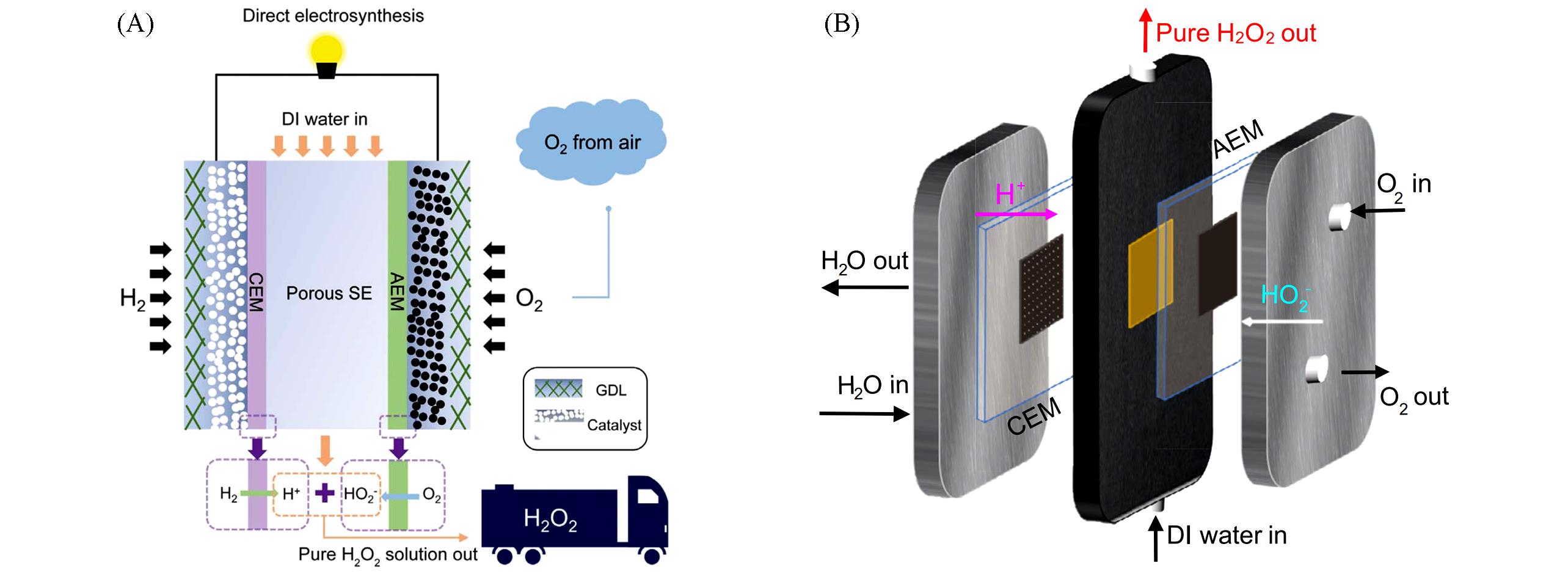
Fig.11 Electrosynthesis of H2O2 using pure H2 and O2 by solid⁃electrolyte cell[3](A) and schematic illustration of the solid⁃electrolyte cell configuration(B)[105](A) Copyright 2019, American Association for the Advancement of Science; (B) Copyright 2021, Springer Nature.
| 1 | Singh D. K., Ganesan V., Yadav D. K., Yadav M., Sonkar P. K., Gupta R., Catal. Sci. Technol., 2021, 11, 1014—1026 |
| 2 | Lu Z., Chen G., Siahrostami S., Chen Z., Liu K., Xie J., Liao L., Wu T., Lin D., Liu Y., Jaramillo T. F., Nørskov J. K., Cui Y., Nat. Catal., 2018, 1, 156—162 |
| 3 | Xia C., Xia Y., Zhu P., Fan L., Wang H., Science, 2019, 366, 226—231 |
| 4 | Sun Y., Han L., Strasser P., Chem. Soc. Rev., 2020, 49, 6605—6631 |
| 5 | Zhang X. L., Su X., Zheng Y. R., Hu S. J., Shi L., Gao F. Y., Yang P. P., Niu Z. Z., Wu Z. Z., Qin S., Wu R., Duan Y., Gu C., Zheng X. S., Zhu J. F., Gao M. R., Angew. Chem. Int. Ed., 2021, 60, 26922—26931 |
| 6 | Dan M., Zhong R., Hu S., Wu H., Zhou Y., Liu Z. Q., Chem. Catal., 2022, 2, 1919—1960 |
| 7 | Yamanaka I., Murayama T., Angew. Chem. Int. Ed., 2008, 47, 1900—1902 |
| 8 | Edwards J. K., Freakley S. J., Lewis R. J., Pritchard J. C., Hutchings G. J., Catal. Today, 2015, 248, 3—9 |
| 9 | Yang S., Verdaguer⁃Casadevall A., Arnarson L., Silvioli L., Čolić V., Frydendal R., Rossmeisl J., Chorkendorff I., Stephens I. E. L., ACS Catal., 2018, 8, 4064—4081 |
| 10 | Dissanayake D. P., Lunsford J. H., J. Catal., 2002, 206, 173—176 |
| 11 | Lunsford J. H., J. Catal., 2003, 216, 455—460 |
| 12 | Edwards J. K., Ntainjua E., Carley A. F., Herzing A. A., Kiely C. J., Hutchings G. J., Angew. Chem. Int. Ed., 2009, 48, 8512—8515 |
| 13 | Liu Q., Bauer J. C., Schaak R. E., Lunsford J. H., Appl. Catal. A, 2008, 339, 130—136 |
| 14 | Abate S., Arrigo R., Schuster M. E., Perathoner S., Centi G., Villa A., Su D., Schlögl R., Catal. Today, 2010, 157, 280—285 |
| 15 | Liu Q., Bauer J. C., Schaak R. E., Lunsford J. H., Angew. Chem. Int. Ed., 2008, 47, 6221—6224 |
| 16 | Freakley S. J., He Q., Harrhy J. H., Lu L., Crole D. A., Morgan D. J., Ntainjua E. N., Edwards J. K., Carley A. F., Borisevich A. Y., Kiely C. J., Hutchings G. J., Science, 2016, 351, 965—968 |
| 17 | Cui L., Zhao X., Xie H., Zhang Z., ACS Catal., 2022, 12, 13334—13348 |
| 18 | Chu Y., Lan C., Luo E., Liu C., Ge J., Xing W., Chem. J. Chinese Universities, 2022, 43, 20220294 |
| 19 | Jung E., Shin H., Lee B. H., Efremov V., Lee S., Lee H. S., Kim J., Hooch Antink W., Park S., Lee K. S., Cho S. P., Yoo J. S., Sung Y. E., Hyeon T., Nat. Mater., 2020, 19, 436—442 |
| 20 | Wang Y., Shi R., Shang L., Waterhouse G. I. N., Zhao J., Zhang Q., Gu L., Zhang T., Angew. Chem. Int. Ed., 2020, 59, 13057—13062 |
| 21 | Wood K. N., O’Hayre R., Pylypenko S., Energy Environ. Sci., 2014, 7, 1212—1249 |
| 22 | Berl E., Trans. Electrochem. Soc., 1939, 76, 359—369 |
| 23 | Hage R.,Lienke A., Angew. Chem. Int. Ed., 2005, 45, 206—222 |
| 24 | Foller P. C., Bombard R. T., J. Appl. Electrochem., 1995, 25, 613—627 |
| 25 | Byers J. C., Guell A. G., Unwin P. R., J. Am. Chem. Soc., 2014, 136, 11252—11255 |
| 26 | Chen C. Y., Tang C., Wang H. F., Chen C. M., Zhang X., Huang X., Zhang Q., ChemSusChem, 2016, 9, 1194—1199 |
| 27 | Edwards J. K., Hutchings G. J., Angew. Chem. Int. Ed., 2008, 47, 9192—9198 |
| 28 | Siahrostami S., Verdaguer⁃Casadevall A., Karamad M., Deiana D., Malacrida P., Wickman B., Escudero⁃Escribano M., Paoli E. A., Frydendal R., Hansen T. W., Chorkendorff I., Stephens I. E., Rossmeisl J., Nat. Mater., 2013, 12, 1137—1143 |
| 29 | Shen Y., Zhu P., Liu B., Yang X., Dong S., Chem. J. Chinese Universities, 2003, 24, 2080—2082 |
| 30 | Huang J., Li Y., Yang S., Zhou Y., Cheng X., Zhu J., Yang J., Chem. J. Chinese Universities, 2018, 39, 1063—1071 |
| 31 | Strasser P., Gliech M., Kuehl S., Moeller T., Chem. Soc. Rev., 2018, 47, 715—735 |
| 32 | Beermann V., Gocyla M., Kuhl S., Padgett E., Schmies H., Goerlin M., Erini N., Shviro M., Heggen M., Dunin⁃Borkowski R. E., Muller D. A., Strasser P., J. Am. Chem. Soc., 2017, 139, 16536—16547 |
| 33 | Strasser P., Acc. Chem. Res., 2016, 49, 2658—2668 |
| 34 | Yang S., Tak Y. J., Kim J., Soon A., Lee H., ACS Catal., 2017, 7, 1301—1307 |
| 35 | Choi C. H., Kim M., Kwon H. C., Cho S. J., Yun S., Kim H. T., Mayrhofer K. J., Kim H., Choi M., Nat. Commun., 2016, 7, 10922 |
| 36 | Calle⁃Vallejo F., Tymoczko J., Colic V., Vu Q. H., Pohl M. D., Morgenstern K., Loffreda D., Sautet P., Schuhmann W., Bandarenka A. S., Science, 2015, 350, 185—189 |
| 37 | Song X., Li N., Zhang H., Wang H., Wang L., Bian Z., J. Power Sources, 2019, 435, 226771 |
| 38 | Zhang B., Xu W., Lu Z., Sun J., Trans. Tianjin Univ., 2020, 26, 188—196 |
| 39 | Gao J., Liu B., ACS Mater. Lett., 2020, 2, 1008—1024 |
| 40 | Tong T., Hu H., Zhou J., Deng S., Zhang X., Tang W., Fang L., Xiao S., Liang J., Small, 2020, 16, e1906206 |
| 41 | Melchionna M., Fornasiero P., Prato M., Adv. Mater., 2019, 31, e1802920 |
| 42 | Wang Y. H., Pegis M. L., Mayer J. M., Stahl S. S., J. Am. Chem. Soc., 2017, 139, 16458—16461 |
| 43 | Wang Z., Huang J., Wang L., Liu Y., Liu W., Zhao S., Liu Z. Q., Angew. Chem. Int. Ed., 2022, 61, e202114696 |
| 44 | Iglesias D., Giuliani A., Melchionna M., Marchesan S., Criado A., Nasi L., Bevilacqua M., Tavagnacco C., Vizza F., Prato M., Fornasiero P., Chem, 2018, 4, 106—123 |
| 45 | Gao J., Yang H. b., Huang X., Hung S. F., Cai W., Jia C., Miao S., Chen H. M., Yang X., Huang Y., Zhang T., Liu B., Chem, 2020, 6, 658—674 |
| 46 | Siahrostami S., Bjorketun M. E., Strasser P., Greeley J., Rossmeisl J., Phys. Chem. Chem. Phys., 2013, 15, 9326—9334 |
| 47 | Verdaguer⁃Casadevall A., Deiana D., Karamad M., Siahrostami S., Malacrida P., Hansen T. W., Rossmeisl J., Chorkendorff I., Stephens I. E., Nano Lett., 2014, 14, 1603—1608 |
| 48 | Siahrostami S., Villegas S. J., Bagherzadeh Mostaghimi A. H., Back S., Farimani A. B., Wang H., Persson K. A., Montoya J., ACS Catal., 2020, 10, 7495—7511 |
| 49 | Jiang K., Back S., Akey A. J., Xia C., Hu Y., Liang W., Schaak D., Stavitski E., Norskov J. K., Siahrostami S., Wang H., Nat. Commun., 2019, 10, 3997 |
| 50 | Koh K. H., Bagherzadeh Mostaghimi A. H., Chang Q., Kim Y. J., Siahrostami S., Han T. H., Chen Z., EcoMat, 2022, 5, e12266 |
| 51 | Chen S., Luo T., Li X., Chen K., Fu J., Liu K., Cai C., Wang Q., Li H., Chen Y., Ma C., Zhu L., Lu Y. R., Chan T. S., Zhu M., Cortes E., Liu M., J. Am. Chem. Soc., 2022, 144, 14505—14516 |
| 52 | Rodriguez P., Koper M. T., Phys. Chem. Chem. Phys., 2014, 16, 13583—13594 |
| 53 | Yang S., Kim J., Tak Y. J., Soon A., Lee H., Angew. Chem. Int. Ed., 2016, 55, 2058—2062 |
| 54 | Oh J. M., Venters C. C., Di C., Pinto A. M., Wan L., Younis I., Cai Z., Arai C., So B. R., Duan J., Dreyfuss G., Nat. Commun., 2020, 11, 1 |
| 55 | Jirkovsky J. S., Panas I., Ahlberg E., Halasa M., Romani S., Schiffrin D. J., J. Am. Chem. Soc., 2011, 133, 19432—19441 |
| 56 | Kunitski M., Eicke N., Huber P., Kohler J., Zeller S., Voigtsberger J., Schlott N., Henrichs K., Sann H., Trinter F., Schmidt L. P. H., Kalinin A., Schoffler M. S., Jahnke T., Lein M., Dorner R., Nat. Commun., 2019, 10, 1 |
| 57 | Shen R., Chen W., Peng Q., Lu S., Zheng L., Cao X., Wang Y., Zhu W., Zhang J., Zhuang Z., Chen C., Wang D., Li Y., Chem, 2019, 5, 2099—2110 |
| 58 | Wang Y., Su H., He Y., Li L., Zhu S., Shen H., Xie P., Fu X., Zhou G., Feng C., Zhao D., Xiao F., Zhu X., Zeng Y., Shao M., Chen S., Wu G., Zeng J., Wang C., Chem. Rev., 2020, 120, 12217—12314 |
| 59 | Fei H., Dong J., Chen D., Hu T., Duan X., Shakir I., Huang Y., Duan X., Chem. Soc. Rev., 2019, 48, 5207—5241 |
| 60 | Chen Y., Ji S., Chen C., Peng Q., Wang D., Li Y., Joule, 2018, 2, 1242—1264 |
| 61 | Zhang B. W., Wang Y. X., Chou S. L., Liu H. K., Dou S. X., Small Methods, 2019, 3, 1800497 |
| 62 | Zhao B., Xue D., Yuan P., Yan W., Zhang J., Mu S., Zhang J. N., Appl. Catal. B, 2023, 324, 122251 |
| 63 | Xue D., Yuan P., Jiang S., Wei Y., Zhou Y., Dong C. L., Yan W., Mu S., Zhang J. N., Nano Energy, 2023, 105, 108020 |
| 64 | Qu G., Guo K., Dong J., Huang H., Yuan P., Wang Y., Yuan H., Zheng L., Zhang J. N., Energy Storage Mater., 2023, 55, 490—497 |
| 65 | Gu Y., Xi B., Li J., Xiong S., Chem. J. Chinese Universities, 2022, 43, 20220036 |
| 66 | Xu S., Yin H., Xue D., Xia H., Zhao S., Yan W., Mu S. C., Zhang J., Chem. J. Chinese Universities, 2022, 43, 20220028 |
| 67 | Liu C., Li H., Liu F., Chen J., Yu Z., Yuan Z., Wang C., Zheng H., Henkelman G., Wei L., Chen Y., J. Am. Chem. Soc., 2020, 142, 21861—21871 |
| 68 | Sun Y., Silvioli L., Sahraie N. R., Ju W., Li J., Zitolo A., Li S., Bagger A., Arnarson L., Wang X., Moeller T., Bernsmeier D., Rossmeisl J., Jaouen F., Strasser P., J. Am. Chem. Soc., 2019, 141, 12372—12381 |
| 69 | Zhao X., Yin Q., Mao X., Cheng C., Zhang L., Wang L., Liu T. F., Li Y., Li Y., Nat. Commun., 2022, 13, 2721 |
| 70 | Zhao C. X., Li B. Q., Liu J. N., Zhang Q., Angew. Chem. Int. Ed., 2021, 60, 4448—4463 |
| 71 | Chen W., Xia H., Guo K., Jin W., Du Y., Yan W., Qu G., Zhang J., Chem. Res. Chin. Univ., 2022, 38, 1232—1238 |
| 72 | Lin L., Ni Y., Shang L., Sun H., Zhang Q., Zhang W., Yan Z., Zhao Q., Chen J., ACS Catal., 2022, 12, 7531—7540 |
| 73 | Gong H., Wei Z., Gong Z., Liu J., Ye G., Yan M., Dong J., Allen C., Liu J., Huang K., Liu R., He G., Zhao S., Fei H., Adv. Funct. Mater., 2021, 32, 2106886 |
| 74 | Tang C., Chen L., Li H., Li L., Jiao Y., Zheng Y., Xu H., Davey K., Qiao S. Z., J. Am. Chem. Soc., 2021, 143, 7819—7827 |
| 75 | Wu K. H., Liu Y., Tan X., Liu Y., Lin Y., Huang X., Ding Y., Su B. J., Zhang B., Chen J. M., Yan W., Smith S. C., Gentle I. R., Zhao S., Chem Catal., 2022, 2, 372—385 |
| 76 | Liu W., Zhang C., Zhang J., Huang X., Song M., Li J., He F., Yang H., Zhang J., Wang D., Appl. Catal. B, 2022, 310, 121312 |
| 77 | Xia F., Li B., Liu Y., Liu Y., Gao S., Lu K., Kaelin J., Wang R., Marks T. J., Cheng Y., Adv. Funct. Mater., 2021, 31, 2104716 |
| 78 | Ding Y., Zhou W., Gao J., Sun F., Zhao G., Adv. Mater. Interfaces, 2021, 8, 2002091 |
| 79 | Zhang J., Zhang J., He F., Chen Y., Zhu J., Wang D., Mu S., Yang H. Y., Nano⁃Micro Lett., 2021, 13, 65—94 |
| 80 | Zhao K., Su Y., Quan X., Liu Y., Chen S., Yu H., J. Catal., 2018, 357, 118—126 |
| 81 | Chen S., Chen Z., Siahrostami S., Kim T. R., Nordlund D., Sokaras D., Nowak S., To J. W. F., Higgins D., Sinclair R., Nørskov J. K., Jaramillo T. F., Bao Z., ACS Sustain. Chem. Eng., 2017, 6, 311—317 |
| 82 | Han L., Sun Y., Li S., Cheng C., Halbig C. E., Feicht P., Hübner J. L., Strasser P., Eigler S., ACS Catal., 2019, 9, 1283—1288 |
| 83 | Xu Z., Liang J., Wang Y., Dong K., Shi X., Liu Q., Luo Y., Li T., Jia Y., Asiri A. M., Feng Z., Wang Y., Ma D., Sun X., ACS Appl. Mater. Interfaces, 2021, 13, 33182—33187 |
| 84 | Jing L., Tang C., Tian Q., Liu T., Ye S., Su P., Zheng Y., Liu J., ACS Appl. Mater. Interfaces, 2021, 13, 39763—39771 |
| 85 | Zhao X., Yang H., Xu J., Cheng T., Li Y., ACS Mater. Lett., 2021, 3, 996—1002 |
| 86 | Jia Y., Chen J., Yao X., Mater. Chem. Front., 2018, 2, 1250—1268 |
| 87 | Zhu J., Mu S., Adv. Funct. Mater., 2020, 30, 2001097 |
| 88 | Dong K., Liang J., Wang Y., Xu Z., Liu Q., Luo Y., Li T., Li L., Shi X., Asiri A. M., Li Q., Ma D., Sun X., Angew. Chem. Int. Ed., 2021, 60, 10583—10587 |
| 89 | Hu Y., Zhang J., Shen T., Li Z., Chen K., Lu Y., Zhang J., Wang D., ACS Appl. Mater. Interfaces, 2021, 13, 29551—29557 |
| 90 | Wang W., Zheng Y., Hu Y., Liu Y., Chen S., J. Phys. Chem. Lett., 2022, 13(38), 8914—8920 |
| 91 | Park J., Nabae Y., Hayakawa T., Kakimoto M. A., ACS Catal., 2014, 4, 3749—3754 |
| 92 | Wohlgemuth S. A., White R. J., Willinger M. G., Titirici M. M., Antonietti M., Green Chem., 2012, 14, 1515—1523 |
| 93 | Favaro M., Perini L., Agnoli S., Durante C., Granozzi G., Gennaro A., Electrochim. Acta, 2013, 88, 477—487 |
| 94 | Bu Y., Wang Y., Han G. F., Zhao Y., Ge X., Li F., Zhang Z., Zhong Q., Baek J. B., Adv. Mater., 2021, 33, e2103266 |
| 95 | Li L., Tang C., Zheng Y., Xia B., Zhou X., Xu H., Qiao S. Z., Adv. Energy Mater., 2020, 10, 2000789 |
| 96 | Zhang Y., Pang Y., Xia D., Chai G., New J. Chem., 2022, 46, 14510—14516 |
| 97 | Fellinger T. P., Hasche F., Strasser P., Antonietti M., J. Am. Chem. Soc., 2012, 134, 4072—4075 |
| 98 | Han G. F., Li F., Zou W., Karamad M., Jeon J. P., Kim S. W., Kim S. J., Bu Y., Fu Z., Lu Y., Siahrostami S., Baek J. B., Nat. Commun., 2020, 11, 2209 |
| 99 | Wu K. H., Wang D., Lu X., Zhang X., Xie Z., Liu Y., Su B. J., Chen J. M., Su D. S., Qi W., Guo S., Chem, 2020, 6, 1443—1458 |
| 100 | Kim H. W., Ross M. B., Kornienko N., Zhang L., Guo J., Yang P., McCloskey B. D., Nat. Catal., 2018, 1, 282—290 |
| 101 | Kim H. W., Park H., Roh J. S., Shin J. E., Lee T. H., Zhang L., Cho Y. H., Yoon H. W., Bukas V. J., Guo J., Park H. B., Han T. H., McCloskey B. D., Chem. Mater., 2019, 31, 3967—3973 |
| 102 | Guo Y., Zhang R., Zhang S., Hong H., Zhao Y., Huang Z., Han C., Li H., Zhi C., Energy Environ. Sci., 2022, 15, 4167—4174 |
| 103 | Chen S., Luo T., Chen K., Lin Y., Fu J., Liu K., Cai C., Wang Q., Li H., Li X., Hu J., Li H., Zhu M., Liu M., Angew. Chem. Int. Ed., 2021, 60, 16607—16614 |
| 104 | Lim J. S., Kim J. H., Woo J., Baek D. S., Ihm K., Shin T. J., Sa Y. J., Joo S. H., Chem, 2021, 7, 3114—3130 |
| 105 | Xia Y., Zhao X., Xia C., Wu Z. Y., Zhu P., Kim J. Y. T., Bai X., Gao G., Hu Y., Zhong J., Liu Y., Wang H., Nat. Commun., 2021, 12, 4225 |
| 106 | Chen S., Chen Z., Siahrostami S., Higgins D., Nordlund D., Sokaras D., Kim T. R., Liu Y., Yan X., Nilsson E., Sinclair R., Norskov J. K., Jaramillo T. F., Bao Z., J. Am. Chem. Soc., 2018, 140, 7851—7859 |
| 107 | Li Z., Kumar A., Liu N., Cheng M., Zhao C., Meng X., Li H., Zhang Y., Liu Z., Zhang G., Sun X., J. Mater. Chem. A, 2022, 10, 14355—14363 |
| 108 | Zhang E., Tao L., An J., Zhang J., Meng L., Zheng X., Wang Y., Li N., Du S., Zhang J., Wang D., Li Y., Angew. Chem. Int. Ed., 2022, 61, e202117347 |
| 109 | Weekes D. M., Salvatore D. A., Reyes A., Huang A., Berlinguette C. P., Acc. Chem. Res., 2018, 51, 910—918 |
| 110 | Burdyny T., Smith W. A., Energy Environ. Sci., 2019, 12, 1442—1453 |
| 111 | Zhao J., Fu C., Ye K., Liang Z., Jiang F., Shen S., Zhao X., Ma L., Shadike Z., Wang X., Zhang J., Jiang K., Nat. Commun., 2022, 13, 685 |
| 112 | Reis R. M., Beati A. A. G. F., Rocha R. S., Assumpção M. H. M. T., Santos M. C., Bertazzoli R., Lanza M. R. V., Ind. Eng. Chem. Res., 2011, 51, 649—654 |
| 113 | Nicoll W. D., Smith A. F., Ind. Eng. Chem., 1955, 47, 2548—2554 |
| 114 | Cota H. M., Katan T., Chin M., Schoenweis F. J., Nature, 1964, 203, 1281 |
| 115 | Zhou W., Jia J., Lu J., Yang L., Hou D., Li G., Chen S., Nano Energy, 2016, 28, 29—43 |
| 116 | Trzesniewski B. J., Diaz⁃Morales O., Vermaas D. A., Longo A., Bras W., Koper M. T., Smith W. A., J. Am. Chem. Soc., 2015, 137, 15112—15121 |
| 117 | Luo E., Chu Y., Liu J., Shi Z., Zhu S., Gong L., Ge J., Choi C. H., Liu C., Xing W., Energy Environ. Sci., 2021, 14, 2158—2185 |
| [1] | LIU Xiaolei, LU Yongqiang, YOU Qi, LIU Guohui, YAO Wei, HU Riming, YAN Jixian, CUI Yu, YANG Xiaofeng, SUN Guoxin, JIANG Xuchuan. A 3-Hydroxythalidomide-based Ratiometric Fluorescent Probe for the Detection of H2O2 [J]. Chem. J. Chinese Universities, 2022, 43(6): 20220070. |
| [2] | ZHOU Shijie, ZHAO Ying, NIU Rui, XU Bo, XUE Dongzhi, WANG Yinghui, ZHANG Hongjie. Novel Biodegradable Nanodrugs ZnO2@Fe3+-TA@PVP for Chemodynamic Therapy [J]. Chem. J. Chinese Universities, 2022, 43(12): 20220554. |
| [3] | GAO Xiaole, WANG Jiaxin, LI Zhifang, LI Yanchun, YANG Donghua. Synthesis of NiOx-ZSM-5 Composite Materials and Its Electrocatalytic Hydrogen Evolution Performance in Microbial Electrolysis Cell [J]. Chem. J. Chinese Universities, 2021, 42(9): 2886. |
| [4] | XU Mengyi, HUANG Xuewen, LI Xiaojie, WEI Wei, LIU Xiaoya. Fabrication of Biosensor Based on “Beads-on-a-String” Shaped Composite Nano-assembly Modified Screen Printed Electrode [J]. Chem. J. Chinese Universities, 2021, 42(6): 1768. |
| [5] | XIE Xingyu, ZHAO Yaxiang, ZHAO Lizhi, LI Rishun, WU Dihao, YE Hui, XIN Qingping, LI Hong, ZHANG Yuzhong. Colorimetric Detection Method for H2O2 Based on Two-dimensional Metal-organic Frameworks of Metalloporphyrin [J]. Chem. J. Chinese Universities, 2020, 41(8): 1776. |
| [6] | WANG Ruixue, YIN Dongmei, SONG Yongxin, SHAN Guiye. Preparation of CuS/Ag2S Nanocomposite and the Peroxidase-like Properties † [J]. Chem. J. Chinese Universities, 2020, 41(6): 1218. |
| [7] | LIU Xinchao,ZHAO Yarong,YUAN Zhenyan,ZHOU Dan,LU Xinhuan,XIA Qinghua. Controllable Synthesis of Ti-Beta Zeolite and Efficiently Catalytic Epoxidation of Cyclohexene† [J]. Chem. J. Chinese Universities, 2019, 40(6): 1222. |
| [8] |
CHEN Yan,DONG Xuejiao,SHAN Guiye.
Preparation of Liposome@Ag/Au Nanocomposites and Their Interaction with H2 |
| [9] |
LU Xinhuan,TAO Peipei,HUANG Fengfeng,ZHANG Xianggui,LIN Zhicheng,PAN Haijun,ZHANG Haifu,ZHOU Dan,XIA Qinghua.
Nano-SnO2 as Highly Efficient Catalyst for Epoxidation of Cyclic Olefins with Aqueous H2 |
| [10] | WANG Hui, PEI Yanbo, HU Shaozheng, MA Wentao, SHI Shuoyu. Synthesis and “Two Channel Pathway” Photocatalytic H2O2 Production Ability of Band Gap Tunable K+ Doped Graphitic Carbon Nitride† [J]. Chem. J. Chinese Universities, 2018, 39(7): 1503. |
| [11] | CAI Zhuang,WANG Guiling,SONG Congying,YANG Xueying,HU Rong,YE Ke,ZHU Kai,CHENG Kui,YAN Jun,CAO Dianxue. Preparation of a Binder Free Electrode of NiAg Supported on Graphite Modified A4 Paper and Its Electrochemical Performance for H2O2 Reduction† [J]. Chem. J. Chinese Universities, 2018, 39(5): 1041. |
| [12] | ZHONG Yong-Ke, LI Gui-Ying*, ZHU Liang-Fang, TANG Dian-Yong, HU Chang-Wei*. Direct Catalytic Hydroxylation of Several Typical Aromatic Compounds over Fe/Activated Carbon Catalyst [J]. Chem. J. Chinese Universities, 2007, 28(8): 1570. |
| [13] | FENG Xia-Guang, ZHANG Min, ZHAO Hu, WANG Huai-You*. Determination of Vancomycin in Injection via Enzyme Catalysis-Fluorescence Quenching Method [J]. Chem. J. Chinese Universities, 2007, 28(7): 1270. |
| [14] | ZHOU Wei, CHUN Yuan, XU Qin-Hua, WANG Cheng, DONG Jia-Lu . A Novel Liquid-solid Isomorphous Substitution Route for Preparing Zeolite Ti-β [J]. Chem. J. Chinese Universities, 2004, 25(1): 16. |
| [15] | LIU Qing-Sheng, YU Jiang-Feng, YE Qiu-Shi, FU Ying-Huan, XU Ning, WU Tong-Hao . Preparation and Characterization of Nanoscales α-Fe2O3/Microporous resin Catalyst and the Application in Hydroxylation of Phenol with H2O2 to Dihydroxybenzene [J]. Chem. J. Chinese Universities, 2002, 23(2): 259. |
| Viewed | ||||||
|
Full text |
|
|||||
|
Abstract |
|
|||||